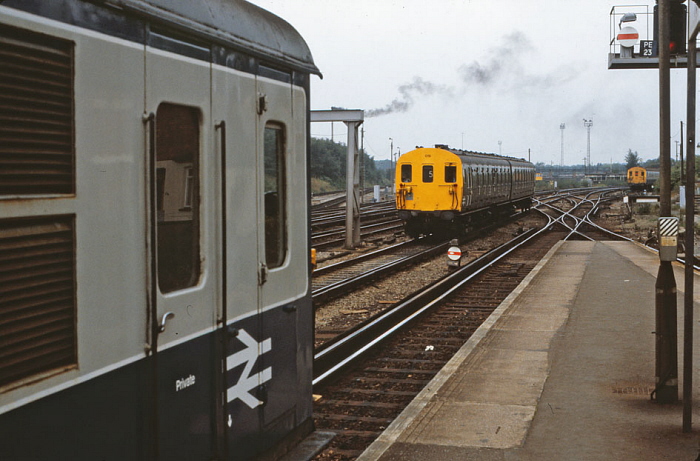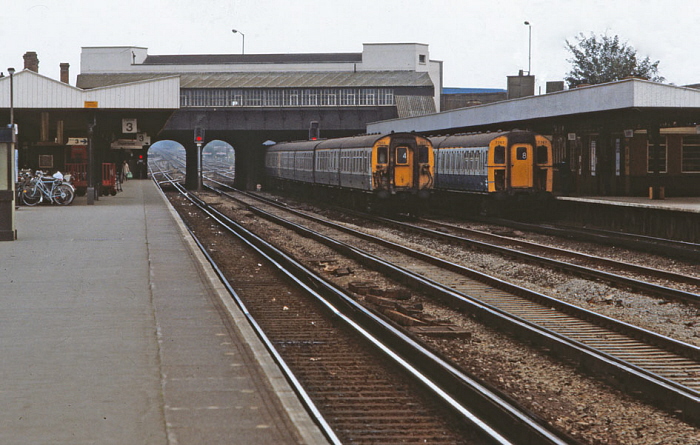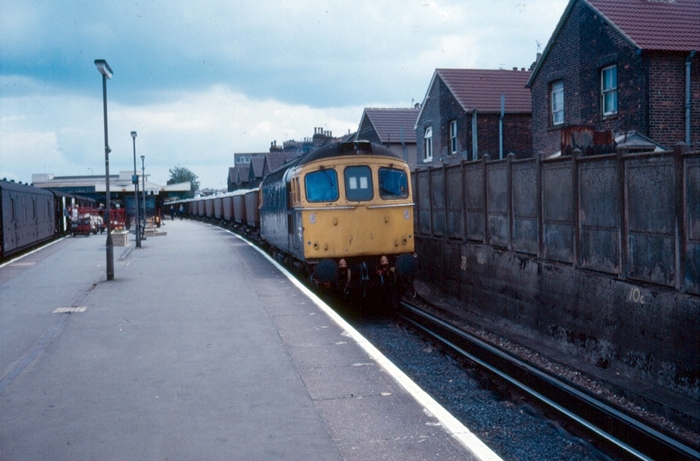
Tonbridge
In 1937, at the SR’s Annual Meeting, the company proposed to electrify five
routes, of which the extension of third rail from Sevenoaks to Hastings and
Bexhill (West) was included. Completion of the necessary works were projected
for January 1939. Electrification to Hastings was swiftly dropped on the basis
that the route featured unusually narrow tunnels requiring the procurement of
expensive tailor-made electric rolling stock. Just two years later, war with
Germany broke out, and as a precaution, ‘’A’’ Box was enclosed from the windows
downwards in a brick casing, to protect it against bomb blast damage. In 1941,
the large area of vacant land in-between diverging Redhill and Sevenoaks routes
was developed into a large marshalling yard to handle wartime freight traffic
diverted away from London. The Redhill tracks were slewed southwards on a new
alignment to accommodate the plethora of sidings, which produced a distinct kink
in the original main line of 1842. A public footpath already existed across this field,
and this was subsequently accommodated within the new yard development upon a
390-feet-long lattice footbridge spanning all tracks.
In November 1946, the SR announced a new electrification scheme involving six
routes, two of which are of direct relevance to this section:
1. Sevenoaks to Ramsgate via Tonbridge, Ashford, Folkestone, Dover, and Deal
2. Tonbridge to West St Leonards, incorporating the Bexhill West branch
The company were overtaken in their proposals by nationalisation in 1948, but a
similar electrification plan, albeit omitting the Hastings line, was pursued by
British Railways. As part of ‘’Phase 2’’ of the Kent Coast Electrification
Scheme, third rail was to be extended from its suburban limit at Sevenoaks to
Dover, via Tonbridge, Ashford, and Folkestone. The Canterbury West branch to
Ramsgate was also to be similarly treated, as were the Maidstone East to Ashford
line and Folkestone Harbour branch. It was also intended to convert the engine
shed at Tonbridge (Code 73J, formerly 74D) into a ‘’diesel garage and fuelling
depot’’. In October 1960, construction of a new ‘’power box’’ commenced at
Tonbridge, within the fork of the diverging Redhill line and West Yard freight
sidings. Equipped with a push button route-setting panel, this was brought into
use on 18th March 1962, initially controlling the Hildenborough to Tonbridge
section of the Sevenoaks line. On 1 May of the same year, the panel’s scope was
extended to Headcorn on the main line and to Yalding on the Medway Valley Line.
Signalling at Headcorn was split between Tonbridge and Ashford Panels, these
controlling the ‘’up’’ and ‘’down’’ loops at the station respectively. The
mechanical cabins at Tonbridge were subsequently taken down and all semaphores
replaced with four-aspect colour lights. The two berthing sidings on the
‘’down’’ side of the incoming Sevenoaks line were electrified, whilst those on
the ‘’up’’ side of the station, parallel with the Redhill line, were retained
but lacked third rail. Four sidings on the southern side of West Yard were also
equipped with third rail for electric stock berthing. Electric working from
Charing Cross to Dover, Ramsgate, and Maidstone West, via Tonbridge, commenced
on 12th June 1961 under existing steam timings. A full diesel service between
Charing Cross and Hastings via Tunbridge Wells had previously started on 9th
June 1958. The full accelerated electric timetable on the main line came into
use on 18th June 1962. Beyond Tonbridge, along the original trunk route to
Redhill, mechanical signalling and steam-hauled services were retained. A diesel
service along the Redhill line commenced on 4th January 1965, using ‘’Tadpole’’
units. Tonbridge engine shed had closed to steam in June of the previous year.
Mechanical signalling along the Tonbridge to Redhill line was finally replaced
by colour lights in spring 1986, and control of the route was split between
Three Bridges and Tonbridge Panels. The next wave of modernisation at Tonbridge
was brought forward in conjunction with works relating to the Channel Tunnel. In
spring 1990, the Government approved electrification of the Redhill to Tonbridge
line to the tune of £19 million, primarily to allow the passage of Chunnel
freight by an alternative route. In addition, quadruple track was to be laid
along the first ¼-mile of the departing Sevenoaks line, and the curve of the
route into the station eased. Advancements in signalling saw a new ‘’Integrated
Electronic Control Centre’’ at Ashford take control of the main line in
September 1993, superseding Tonbridge ‘’power box’’ on 27th of that month. The
latter, however, remained to control the Hastings line. Diesel services between
Tonbridge and Redhill ended in 1994, on completion of electrification, but the
commencement of Chunnel freight over the line stalled. The Class 92 electric
locomotives, procured specifically for the purpose of hauling such trains,
started to fall foul to new signalling interference criteria. By summer 1996, a
privatised ‘’Railtrack’’ had assumed control of former British Rail
infrastructure, and was quick to put in place stringent regulations concerning
interference between motive power and signalling equipment. Thus, Class 92s were
banned from operating over the Wembley to Dollands Moor via Redhill route, which
had been earmarked for them in the original Chunnel specification. The use of
the line by ‘’Eurostar’’ services had been a non-starter from the outset, since
limited clearances at East Croydon prevented the running of Trans Manche Super
Train stock.
Final mention must now be made of the ‘’down’’ bay platform at Tonbridge, which
for many years was dedicated to mail traffic. In 1995, a new rail-served
platform to replace this facility came into use alongside Royal Mail’s huge
sorting centre, ⅔-mile east of the station. This was commissioned as part of the
modernisation of the mail by rail operation, which included the delivery of
seventeen new Class 325 four-vehicle electric multiple units.
Summer 1984

A London-bound view in 1984 reveals the rear of a ''Hastings'' formation, awaiting departure to its namesake, whilst taking the through line is Bulleid 2EPB No. 019, which at that time was in departmental service. © Chris
Summer 1984

4 CEP No. 1528 is observed speeding through the arched bridge on the ''up'' through line, forming a fast service to Charing Cross. Stabled in platform 2 is 4 Vep No. 7767, forming an Ashford to Charing Cross semi-fast service. Platform 4, just out of view on the left, formerly handled Royal Mail traffic, before the 1995 opening of the dedicated platform at Tonbridge Sorting Centre. © Chris
27th June 1985

Class 33 No. 33206 is seen entering the ''up'' island with a rake of fully laden hoppers, on a Mountfield to Northfleet gypsum working. On the right, platform 2 was being used by a mail train (which, your author will stress, did not always use the ''down'' bay!). © David Glasspool Collection
Return to the Kent Rail Homepage or alternatively, check for Updates.
Website & Copyright information - Links - Contact the Webmaster
All content is copyright © David Glasspool unless otherwise stated